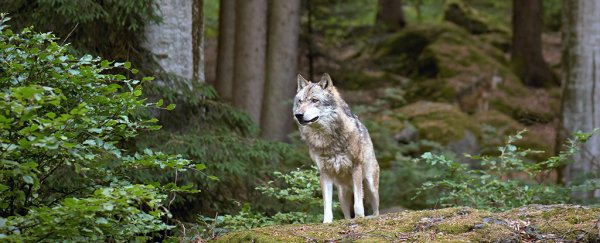The Chernobyl nuclear disaster of 1986 left a landscape that was highly toxic, but in the 30 years since we've seen small signs of nature recovering. Earlier this year it was evidence of a young wild wolf boldly making its way far out of the designated Chernobyl Exclusion Zone or CEZ.
Covering some 4,300 square kilometres (1,660 square miles), the zone is still considered too contaminated to be habitable, but some wildlife in the area seems to be flourishing without interference from human activity.
Now those animals are pushing the boundaries of the zone, specifically a young, male grey wolf which was recorded in July venturing some 369 kilometres (229 miles) from its home.
 Wolf travels. (Byrne et al)
Wolf travels. (Byrne et al)
It was the first time scientists know of that an animal leaving the zone has covered such a distance, and it could be a sign of how these populations might spread in the future – and how far genes mutated by the nuclear radiation could spread.
"Instead of being an ecological black hole, the Chernobyl Exclusion Zone might actually act as a source of wildlife to help other populations in the region," one of the researchers, Michael Byrne from the University of Missouri at Columbia, told Charles Q. Choi at Live Science.
"And these findings might not just apply to wolves – it's reasonable to assume similar things are happening with other animals as well."
The data on the one- or two-year-old wolf was collected back in February 2015 with the help of a GPS collar, but the study analysing it is brand new.
After attaching the collar and releasing the wolf back into the wild, the scientists tracked it covering a lengthy distance across Ukraine away from the CEZ, with the animal largely sticking to forests and areas used for farming.
This wide-ranging exploration is not unusual for the grey wolf, but it's not something that's previously been logged with wolves born in the CEZ. A total of 13 other, older wolves had GPS collars attached at the same time as part of the same study, but largely kept to their home areas.
What's not clear is what happened to the wolf – the GPS collar broadcasted its last location several months after it should have automatically disengaged. The researchers weren't able to retrieve it though, so they don't know if the collar malfunctioned, or if the wolf died while still wearing it, far from the CEZ.
The overall effect the Chernobyl disaster has had on local wildlife populations still isn't clear to scientists. Studies have spotted both high increases in mutation rates in certain animals as well as evidence of growing population levels, but the overall picture is hazy.
Grey wolves (Canis lupus) in particular have flourished: some estimates say there are seven times the population density of wolves in the exclusion zone as there are in nature reserves outside it.
Now we know that at least one determined wolf has pushed well out of the CEZ, it's a starting point for further research into the movements of animals outside the zone.
Not only could we learn more about how nuclear fall-out can affect wildlife, further studies could also reveal how genetic mutations might make it out into the wider animal population – though just how much mutation there has been is another contentious issue among scientists.
Byrne did confirm to Live Science that the wolves his team tracked all had four legs, two eyes and one tail, and weren't glowing green – but we don't have any hard data on how these wolves might differ genetically from other populations.
"It is worth exploring how the CEZ may serve as a source for some wildlife populations rather than a sink as has been previously suggested," write the researchers.
"Considering the high population density of wolves specifically relative to neighbouring uncontaminated reserves (up to seven times greater), it is appropriate to speculate that wolves born in the CEZ regularly disperse into surrounding populations."
The research was published in the European Journal of Wildlife Research.
A version of this article was first published in July 2018.
